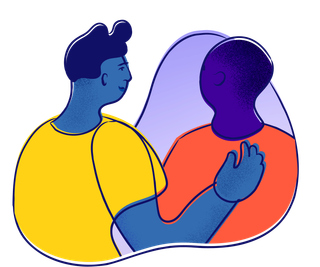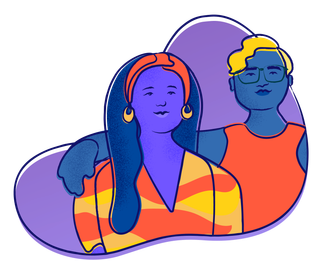Introduction
The Trevor Project’s 2024 U.S. National Survey on the Mental Health of LGBTQ+ Young People amplifies the experiences of more than 18,000 LGBTQ+ young people ages 13 to 24 across the United States.
For the sixth year, the U.S. National Survey uncovers the reality that there is a significant association between anti-LGBTQ+ victimization and disproportionately high rates of suicide risk — and that far too many young people struggle to access the mental health care they need.
The survey critically provides data-driven ways we can all show support and acceptance for the LGBTQ+ young people in our lives, based on their own responses — as well as the potentially life-saving benefits of creating affirming spaces and communities.
For the first time, we asked respondents to share a message of advice or encouragement to other young people in the LGBTQ+ community. There is no doubt that this has been a challenging year for LGBTQ+ young people. Yet despite these challenges, including the historic wave of anti-LGBTQ+ legislation that has targeted them, these young people remain powerful, optimistic, and resilient.
The Trevor Project remains unwavering in our commitment to support them, and we will continue fighting toward a world where all LGBTQ+ young people feel safe, accepted, and loved exactly as they are.
Thank you to all the LGBTQ+ young people who took this survey, honestly and bravely sharing their experiences with us. We hope these findings help to equip fellow researchers, policymakers, educators, and other youth-facing professionals and organizations with the data they need to protect and uplift LGBTQ+ young people in their communities and to help us end the public health crisis of suicide, once and for all.
- The Trevor Project
Want to help support The Trevor Project?
Your donation helps to support future, meaningful research about LGBTQ+ youth and power the life-saving services we provide.
Donate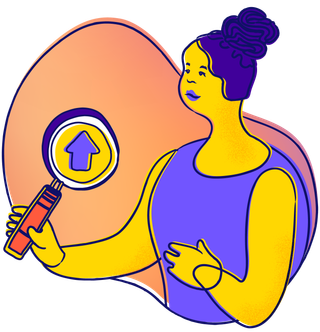
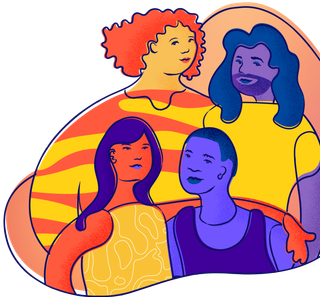
Key Findings


39% of LGBTQ+ young people seriously considered attempting suicide in the past year — including 46% of transgender and nonbinary young people. LGBTQ+ youth of color reported higher rates than White peers.


More than 1 in 10 (12%) LGBTQ+ young people attempted suicide in the past year.


50% of LGBTQ+ young people who wanted mental health care in the past year were not able to get it.


More than half (54%) of transgender and nonbinary young people found their school to be gender-affirming, and those who did reported lower rates of attempting suicide.


90% of LGBTQ+ young people said their well-being was negatively impacted due to recent politics.


45% of transgender and nonbinary young people reported that they or their family have considered moving to a different state because of LGBTQ+-related politics and laws.

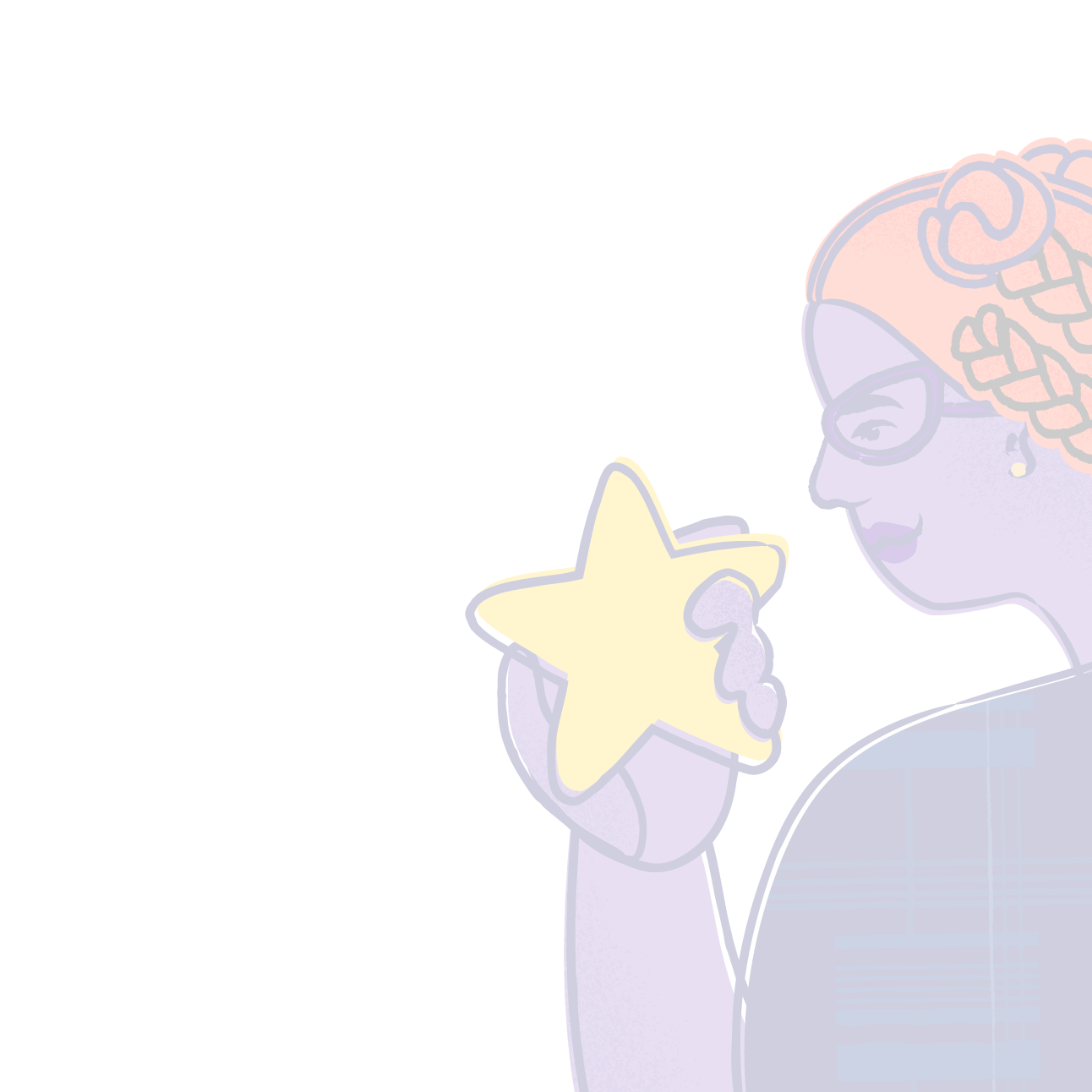
Nearly half (49%) of LGBTQ+ young people ages 13-17 experienced bullying in the past year, and those who did reported significantly higher rates attempting suicide in the past year than those who did not experience bullying.


LGBTQ+ young people who reported living in very accepting communities attempted suicide at less than half the rate of those who reported living in very unaccepting communities.
Mental Health & Suicide Risk:
Suicide Risk

39% of LGBTQ+ young people seriously considered attempting suicide in the past year
including almost half of transgender and nonbinary young people (46%) and 3 in 10 cisgender young people (30%).

12% of LGBTQ+ young people attempted suicide in the past year
including 14% of transgender and nonbinary young people and 7% of cisgender young people.
Rates of considered and attempted suicide among LGBTQ+ young people

10% of White young people attempted suicide in the past year
compared to…
-
24%
of Native/
Indigenous young people - 16% of multiracial young people
-
14%
of Middle Eastern/
Northern African young people -
14%
of Black/
African American young people -
13%
of Hispanic/
Latinx young people -
10%
of Asian American/
Pacific Islander young people
Anxiety & Depression

66% of LGBTQ+ young people reported experiencing recent symptoms of anxiety
including over 7 in 10 transgender and nonbinary young people (71%) and nearly 3 in 5 cisgender young people (58%).

53% of LGBTQ+ young people reported experiencing recent symptoms of depression
including nearly 3 in 5 transgender and nonbinary young people (59%) and more than 2 in 5 cisgender young people (44%).
Anxiety & depression symptoms reported among LGBTQ+ young people
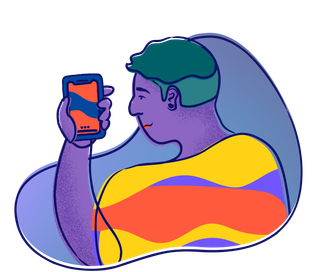
Access to Care
Despite the prevalence of anxiety, depression, and suicide risk among LGBTQ+ young people, half of them were not able to access the mental health care they desired. And among the small percentage of transgender and nonbinary young people who said they received gender-affirming medical care, nearly 3 in 5 were worried about losing access to this care.

Access to Care:
Mental Health Care

Among all LGBTQ+ young people, 84% wanted mental health care.

50% of LGBTQ+ young people who wanted mental health care in the past year were not able to get it
including nearly half of transgender and nonbinary young people (49%) and more than half of cisgender young people (52%).

Among the 42% of LGBTQ+ young people who received psychological or emotional counseling in the past 12 months
the majority accessed services through in-person one-on-one therapy (69%) or virtual/online therapy over video (53%).
Desire for and access to mental health care
Desire for mental health care
-
84% Yes
-
16% No
Access to mental health care
-
50% Wanted but did not receive care
-
50% Wanted & received care
LGBTQ+ young people who wanted mental health care but were unable to get it cited the following top ten reasons:
Gender-Affirming Medical Care

Among transgender and nonbinary young people, 13% reported being on gender-affirming hormones, and 2% reported taking puberty blockers.

61% who were on gender-affirming hormones were somewhat or very concerned about losing access to this care.

The overwhelming majority (90%) of LGBTQ+ young people said their well-being was negatively impacted due to recent politics. Over half (53%) said their well-being was negatively impacted by politics a lot.

Nearly 2 in 5 (39%) LGBTQ+ young people said that they or their family have considered moving to a different state because of anti-LGBTQ+ politics and laws.

Nearly half (45%) of transgender and nonbinary youth reported that they or their family have considered moving to a different state due to anti-LGBTQ+ politics and laws.
How often have recent politics negatively impacted your well-being?
-
10% Never
-
37% Sometimes
-
53% A lot

Anti-LGBTQ+ Victimization
Experiences of anti-LGBTQ+ victimization were associated with higher suicide risk among LGBTQ+ young people. In separate analyses, those who reported being physically threatened or harmed, discriminated against, subjected to conversion therapy, or bullied because of their sexual orientation or gender identity had more than twice the rate of attempting suicide in the past year, compared to LGBTQ+ young people who did not report any of these anti-LGBTQ+ experiences.

Anti-LGBTQ+ Victimization:
Negative Experiences at School
Among those enrolled, LGBTQ+ young people reported that these negative experiences happened to them while in school:
Physical Harm

23% of LGBTQ+ young people reported that they have been physically threatened or harmed in the past year due to either their sexual orientation or gender identity.

15% of LGBTQ+ young people reported that they have been physically threatened or harmed in the past year due to their sexual orientation.

28% of transgender and nonbinary young people reported that they have been physically threatened or harmed in the past year due to their gender identity.
Rates of LGBTQ+ young people who have been physically threatened or harmed in the past year
Rates of LGBTQ+ young people who have been physically threatened or harmed in the past year
LGBTQ+ young people who attempted suicide in the past year, comparison across those who:
Discrimination

60% of LGBTQ+ young people reported that they have felt discriminated against in the past year due to their sexual orientation or gender identity.

46% of LGBTQ+ young people reported that they have felt discriminated against in the past year due to their sexual orientation.

65% of transgender and nonbinary young people reported that they have felt discriminated against in the past year due to their gender identity.
Rates of LGBTQ+ young people who have felt discriminated against in the past year
Rates of LGBTQ+ young people who have felt discriminated against in the past year
LGBTQ+ young people who attempted suicide in the past year, comparison across those who:
Conversion Therapy
LGBTQ+ young people who reported being threatened with or subjected to conversion therapy:
-
87% Not threatened with or subjected to conversion therapy
-
8% Threatened with conversion therapy
-
5% Subjected to conversion therapy

13% of LGBTQ+ young people reported being threatened with or subjected to conversion therapy
including approximately 1 in 6 transgender and nonbinary young people (16%) and nearly 1 in 10 cisgender young people (9%).
Rates of being threatened with or subjected to conversion therapy among LGBTQ+ young people
LGBTQ+ young people who attempted suicide in the past year, comparison across those who:
Bullying

49% of LGBTQ+ young people ages 13-17 reported being bullied in-person within the past year, and 26% of those ages 18-24 reported the same.

35% of LGBTQ+ young people ages 13-17 reported that they had been electronically (cyber) bullied during the past year, and 24% of those ages 18-24 reported the same.

LGBTQ+ young people who experienced bullying of any kind reported three times the rate of attempting suicide in the past year compared to those who were not bullied.
LGBTQ+ young people who attempted suicide in the past year, comparison across those who:
Ways to Support LGBTQ+ Young People:

LGBTQ+ young people who had access to LGBTQ+-affirming spaces, and transgender and nonbinary youth who had access to gender-affirming spaces, reported lower rates of attempting suicide compared to those who did not.

Transgender and nonbinary young people who had access to gender-affirming clothing, gender-neutral bathrooms at school, and had their pronouns respected by the people they live with had lower rates of attempting suicide compared to those who did not.

Most LGBTQ+ young people who attend school (78%) reported having at least one adult at school who is supportive and affirming of their LGBTQ+ identity.
LGBTQ+ young people reported the following top ten actions as ways people in their life can best show their support and acceptance:
Access to Affirming Spaces and Communities
Affirming spaces among LGBTQ+ young people:
Affirming spaces among transgender and nonbinary young people:
LGBTQ+ young people who attempted suicide in the past year, comparison across access to LGBTQ+-affirming spaces:
*There was no significant difference in the suicide attempt rate among LGBTQ+ young people who had access to LGBTQ+-affirming worship spaces compared to those who did not.
Transgender and nonbinary young people who attempted suicide in the past year, comparison across access to gender-affirming spaces:
*There was no significant difference in the suicide attempt rate among transgender and nonbinary young people who had access to gender-affirming worship spaces compared to those who did not.
How accepting of LGBTQ+ people is the community where you currently live?
-
13% Very unaccepting
-
23% Somewhat unaccepting
-
48% Somewhat accepting
-
16% Very accepting
LGBTQ+ young people who attempted suicide in the past year, comparison across access to how accepting of LGBTQ+ people are in their communities:
Supporting Transgender and Nonbinary Youth
Transgender and nonbinary young people reported lower rates of attempting suicide when all of the people they live with respected their pronouns and/or they had access to a gender-neutral bathroom at school.
How many of the people you live with respect your pronouns?
-
37% None of the people I live with
-
27% Some of the people I live with
-
37% All of the people I live with
Transgender and nonbinary young people who attempted suicide in the past year, comparison across the number of people they live with who respected their pronouns:
Is there a gender neutral bathroom at your school?
-
54% No
-
46% Yes
Transgender and nonbinary young people who attempted suicide in the past year, comparison across having a gender-neutral bathroom at their school:
Transgender and nonbinary young people who had access to binders, shapewear, and gender-affirming clothing reported lower rates of attempting suicide in the past year compared to those who did not:*
*Binders and shapewear refer to undergarments, such as tank tops or bodysuits, that help young people who are experiencing gender dysphoria align the appearance of their body with their gender identity.
Most LGBTQ+ young people (65%) reported knowing at least one older LGBTQ+ person they would consider a role model or someone they look up to.
Older LGBTQ+ role models identified by respondents:

Advice and Encouragement from LGBTQ+ Young People
We asked LGBTQ+ young people to share a message of advice or encouragement to other young people in the LGBTQ+ community. Here were some of their responses:
- You have millions of queer siblings across the world who would accept you for who you. It is the most rewarding experience to live sourrounded by people who love you for your whole, true self.
- Finding a community, people you can be yourself aroud, is life changing
- You aren't alone my friend. Remember, there's a whole wide world with people like you and me.
- Be the role model you always needed.
- Treat yourself as a friend.
- You've come so far, and I am so, so proud of you.
- You are so extremely valid and I am prod of you.
- Keep on going, you're strong for existing.
- You are enough.
- The greatest act of rebellion is to go on living authentically and truthfully; find spaces where you can be yourself unapologetically.
- Just remember no one else can decide who you are for you, you know yourself the best and nothing and no one can change that.
- We deserve happiness. We're allowed to want a future of our own design, with the people we love. One day I'll get that and so will you.
- Finding out who you truly are take time. You've got this.
- You don't have to figure it out now, and you're allowed to not know. Figuring it out is for YOU first and foremost, so do it in your time and in your way.
- Takes as much time as you need to figure things out. There's no time limit.
- Nothing is better than living your authentic self, but you don't need to rush it. If the time isn't right, it just isn't right.
- You are beatiful! You bring so much light into the world and there is so much joy out there waiting for you.
- Queerness is glorious and essential and deeply human. It is poetry and starlight. Thank you for being here!


Methodology
The content and methodology for The Trevor Project’s 2024 U.S. National Survey on the Mental Health of LGBTQ+ Young People were approved by an independent Institutional Review Board.
A quantitative cross-sectional design was used to collect data through an online survey platform between September 13 and December 16, 2023. A sample of individuals ages 13 to 24 who resided in the United States, including its territories, was recruited via targeted ads on social media. No recruitment was conducted via The Trevor Project’s website or social media channels. Respondents were defined as being LGBTQ+ if they identified with a sexual orientation other than straight/heterosexual, a gender identity other than cisgender, or both. In order to ensure a diverse sample, targeted recruitment was conducted to ensure adequate sample sizes with respect to geography, gender identity, and race/ethnicity. Qualified respondents completed a secure online questionnaire that included a maximum of 134 questions. The questionnaire was offered in English and Spanish. Questions on considering and attempting suicide in the past year were taken from the Centers for Disease Control and Prevention’s Youth Risk Behavior Survey to allow for comparisons to their nationally representative sample. Each question related to mental health and suicide was preceded by a message stating, “If at any time you need to talk to someone about your mental health or thoughts of suicide, please call The Trevor Project at 1-866-488-7386 or the National Suicide Prevention Lifeline at 1-800-273-8255 or 988.”
A total of 72,424 individuals began the survey. However, 17,078 did not consent and 5,259 did not pass demographic screening requirements (e.g., age, United States [U.S.] residency, being LGBTQ+). This resulted in an eligible sample of 50,087 LGBTQ+ young people ages 13 to 24 in the U.S. Of those, 29,768 did not pass completion requirements (i.e., spend at least 5 minutes on the survey and complete at least 50% of it), 468 did not pass attention or honesty checks, and 1,188 did not pass duplicate or bot checks (e.g., built-in Qualtrics checks, IP address matching). This resulted in a final analytic sample of 18,663 LGBTQ+ young people ages 13 to 24 in the U.S.
Chi-square tests were used to examine differences between groups. Unless otherwise noted, all reported comparisons are statistically significant at least at p<0.05. This means there is less than a 5% likelihood these results occurred by chance.
This report uses “transgender and nonbinary” as an umbrella term to encompass non-cisgender young people, which includes young people who identify as transgender and nonbinary as well as other labels outside of the cisgender binary, including genderqueer, agender, genderfluid, gender neutral, bigender, androgynous, and gender non-conforming, among others.
Comparability
In order to better understand how our sample compares to a national probabilistic sample, we included questions regarding considering and attempting suicide that were identical to those used by the Centers for Disease Control and Prevention (CDC) in their Youth Risk Behavior Survey (YRBS).
Analyses were conducted to compare rates of seriously considering suicide and attempting suicide in the past 12 months among young people ages 13 to 18 in our sample (n = 11,346) to the 2021 YRBS sample of high school students who identify as lesbian, gay, bisexual, questioning, or another non-heterosexual identity (LGBQ+; n = 3,850).
The YRBS rate among LGBQ+ young people for seriously considering suicide in the past year (45%) was similar to the rate among the same age range in our sample of LGBTQ+ young people (44%).
Additionally, 22% of LGBQ+ young people in the 2021 YRBS reported a suicide attempt in the past 12 months compared to 14% in our sample of LGBTQ+ young people ages 13 to 18.
Sample Breakdown of Respondents’ Demographics
By age
-
49% 13–17
-
51% 18–24
By sexual orientation
-
4% Straight or Heterosexual
-
13% Gay
-
16% Lesbian
-
28% Bisexual
-
16% Pansexual
-
12% Queer
-
1% Questioning
-
10% Asexual
By gender identity
-
33% Girl or Woman
-
28% Boy or man
-
33% Nonbinary, bigender, genderfluid, or genderqueer
-
6% Not sure or questioning
By transgender & nonbinary identity
-
41% Cisgender
-
6% Questioning if transgender or nonbinary
-
53% Transgender or nonbinary
By race/ethnicity
-
<1% Middle Eastern/Northern African
-
1% Native/Indigenous
-
6% Asian American/Pacific Islander
-
8% Black/African American
-
12% Hispanic/Latinx
-
12% More than one race/ethnicity
-
61% White
By socioeconomic status
-
73% More than meets basic needs
-
27% Just meets basic needs or less
By region
-
16% Northeast
-
35% South
-
23% Midwest
-
26% West
By intersex
-
98% No
-
2% Yes
Acknowledgements:
The Trevor Project’s Research team expresses deep gratitude to all of the LGBTQ+ young people who participated in the survey and shared their insights. Special thanks to Greg Thomas, Abie Peacock, and Kinzi Sparks for their leadership in recruitment efforts. We also extend our appreciation to Antonia Clifford, Alfredo Pizaña, Carrie Davis, Fiona Hilton, Joseph Kwan, Kasey Suffredini, Kevin Wong, Megan Ford, Miranda Jaramillo, Dr. Myeshia Price, Nathanio Strimpopulos, Nelson Fernandez, Nolan Scott, Paul Pham, Ryan Bernsten, Steve O’Donoghue, Sue Cardenas-Soto, William Young, and Zach Eisenstein for their contributions to the research.
Suggested citation:
Nath, R., Matthews, D.D., DeChants, J.P., Hobaica, S., Clark, C.M., Taylor, A.B., Muñoz, G. (2024). 2024 U.S. National Survey on the Mental Health of LGBTQ+ Young People. West Hollywood, California: The Trevor Project. www.thetrevorproject.org/survey-2024



